A Chinese diplomat observes Moroccan life and customs up close.
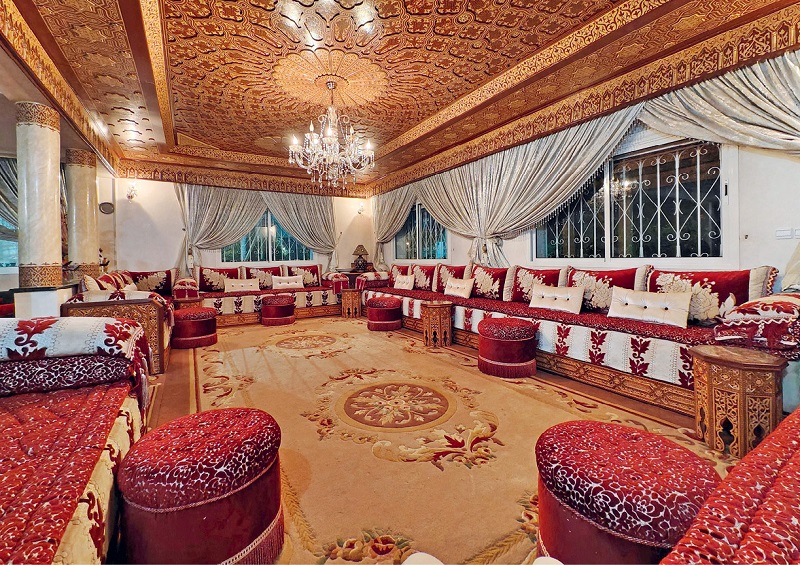
A traditional sitting room in a Moroccan home.
Morocco is known as the Garden of North Africa for its beautiful scenery. Moroccans are suave, open-minded, and hospitable, especially to foreigners. During my work here, I have made many friends with people from all walks of life. As a result, this has given me the opportunity to visit local families and experience Moroccan hospitality first-hand.
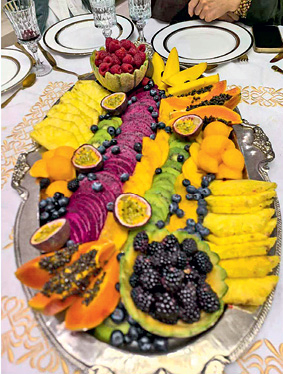
Couscous, a North African delicacy.
Inviting Guests Home
Moroccans are very punctual people. No one I have met here, from government officials to private citizens, has ever been late for an appointment. They always meet me at the gate of their office or residence when I arrive, and then accompany me to my car when I leave. Moroccans may invite you to their home for tea or dinner soon after getting acquainted with you. For important guests, the host dresses up in a djellaba, a traditional Moroccan robe, to greet them at the door, and offers dates and milk upon their arrival.
In the sitting room of a home, the main table is full of beverages, pastries, and dried fruits, including corne de gazelle, honey-almond briouate, walnut-almond ghoriba bahla, date makroud, and other Moroccan desserts. A professional waiter is often hired by the host to serve guests. A singer may also be present to perform to live music played by a small band.
In the corner of the room a tea maker dressed in traditional clothes sits on the floor with jars of herbs in front of him. He will make tea for the guests from the herbs they choose. These herbs are believed to have different therapeutic properties, like lowering high blood pressure, stimulating digestion, or restoring energy.
When I visit my Moroccan friends in their homes, I often talk with them about Chinese green tea, which is a daily necessity for them. They often jokingly claim that half of their body is green tea, and emphasize that they make the tea in siniya, meaning “a Chinese object” in Arabic. In response to this statement, I remind them that Morocco imports the largest amount of green tea from China, reaching about 70,000 tons every year. These tiny leaves have played a unique role in bringing the Chinese and Moroccan people closer.
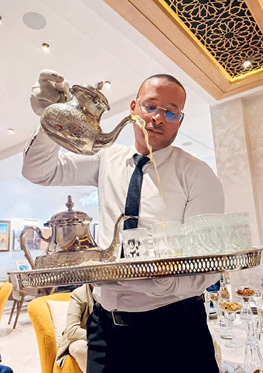
A professional waiter hired by the host to serve guests at a party.
Moroccan homes are spacious and have distinctive cultural features. Rabat, the city where I am stationed, has strict building codes: A residential building cannot exceed two floors.
Most of the families I have visited are families of officials or business people. After entering their homes, the host usually shows me around. What has caught my attention is that even though residences cover a large area, the entrances are quite small, projecting an air of modesty. There are at least two or three living rooms of varying sizes, including one with sofas against the walls. A friend, who hosted me, told me that an important function of this living room is to accommodate friends and family who come for parties during vacations or holidays during the night. Another point that impressed me was that in many homes I have seen objects with Chinese elements, such as Chinese panel screens, vases, tableware, and miniature terracotta warriors. The host is glad to share stories behind these Chinese decorations.
Almost all homes have a large lawn and an outdoor swimming pool. Most people bought the land 20 or 30 years ago when it was less expensive, and then took about three to four years to build a home on it. When I walked around my neighborhood on one night, I saw a family setting up a tent in their yard. I asked why and learned that it was for a wedding on Saturday night. Only the parents’ home has the space to host large events.
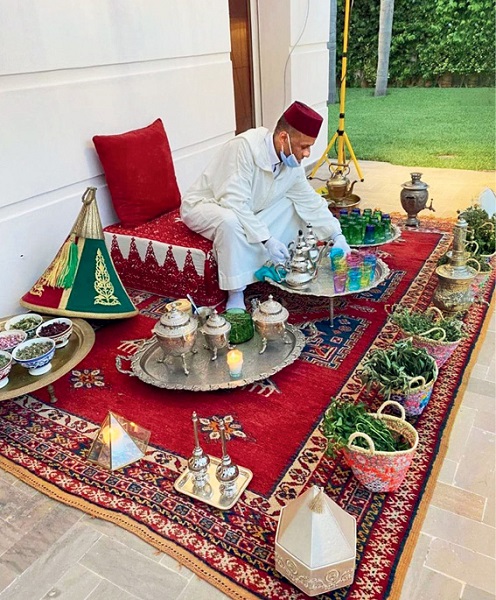
A traditional tea maker.
Preparing Scrumptious Dishes
Moroccans treat their guests with lavish food. They are proud to tell me that Moroccan cuisine is the third best in the world after Chinese and French. All Chinese visitors to Morocco eagerly try the local food, and are impressed with the large serving sizes and the mouthwatering flavors. Moroccans usually dine with guests at round tables, believing it is cozier to sit together in a circle.
For a full course meal, the appetizers, which are equivalent to Western-style salads, include eggplants, carrots, pumpkins, and tomato puree. As for the main courses, the most popular are: pastilla, a puff pastry wrapped in shrimp, squid and other seafood for the salty version, or pigeon or chicken with onions, lemons, eggs, and roasted sweet almonds for the sweet version; mechoui, roasted whole lamb or mutton with salt and cumin; tagine, similar to the stew popular in northeast China, with the most common varieties being beef with plum tagine, chicken with lemon and olive tagine, and fish tagine; and couscous, served with lamb and vegetables, or totally vegetarian. Among the soups, harira is the most famous. It is a sweet and sour thick soup that consists of beef or lamb, tomatoes, onions, chickpeas, cilantro, saffron, and other herbs.
During his recent stopover at the Casablanca airport, President Xi Jinping met with Moroccan Crown Prince Moulay El Hassan in the VIP lounge. After the scene of the two having dates together was aired on TV, many of my friends in Morocco told me that it was heartwarming to see President Xi show such respect for their traditional customs.
Not long ago, 10 of my classmates came to Morocco for a visit, and I took them to visit the homes of several friends. They prepared a full set of traditional Moroccan dishes, and all my classmates were deeply moved by their kindness and generosity.
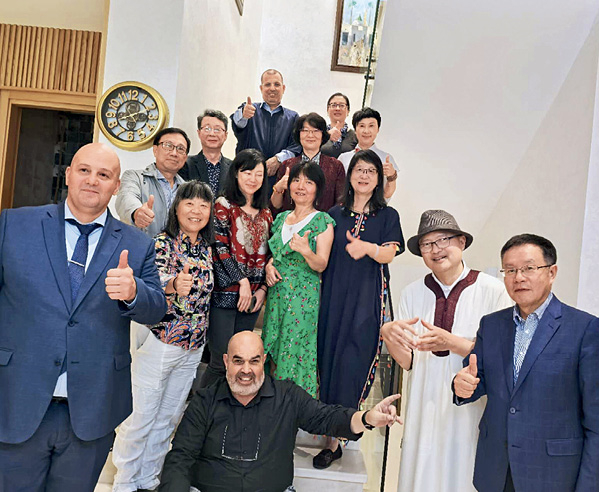
The author (first from right) and his classmates at the home of a Moroccan friend. Photos courtesy of the author
Maintaining Friendships
Exchanging gifts is a highly valued custom in Moroccan culture, as it is seen as an important way of conveying friendship. According to Moroccan custom, the first time you visit someone’s home, you should bring a gift, which can range from a traditional handicraft, dessert, flowers and books to picture albums. If you are invited to a wedding, it’s a good idea to bring a handicraft gift that is unique to your country.
Not long ago, I met a chocolatier in Casablanca, and we soon became good friends. Since then, he began to send me chocolates from time to time, which I happily share with my colleagues. My driver Mohammed sends me a birthday gift almost every year. The gifts have included the djellaba, and a framed picture of me attending an international event. In return, I have also sent him some Chinese gifts as an expression of my gratitude.
Moroccans respond with acts of kindness after getting help from others. A popular gesture is presenting a medal or certificate with the recipient’s photo or name printed on it. Over the past years, I have received medals and trophies from several Moroccan organizations that recognize China’s support for martial arts competitions, international tourism forums, Chinese language teaching programs and other activities in the country.
When addressing a meeting for Chinese diplomatic envoys at the end of 2023, President Xi encouraged us to make more friends in countries in which we are stationed, including both officials and members of the general public. During his meeting with Crown Prince Hassan in Casablanca also, he stressed that China and Morocco should expand people-to-people exchanges to strengthen the foundation of friendship between the two countries.
In order to better implement his instructions, I think we diplomats should establish friendships with more Moroccans from all walks of life, visit more local people’s families, and learn more about the country. In January 2025, China Eastern Airlines started a flight between Shanghai and Casablanca with a stopover in Marseille. During the same month, Royal Air Maroc resumed direct flights between Beijing and Casablanca. It is expected that there will be a strong increase in two-way visits between our countries in the coming years. This will lay a solid foundation for bilateral cooperation in all fields. 
LI CHANGLIN is the Chinese ambassador to Morocco.